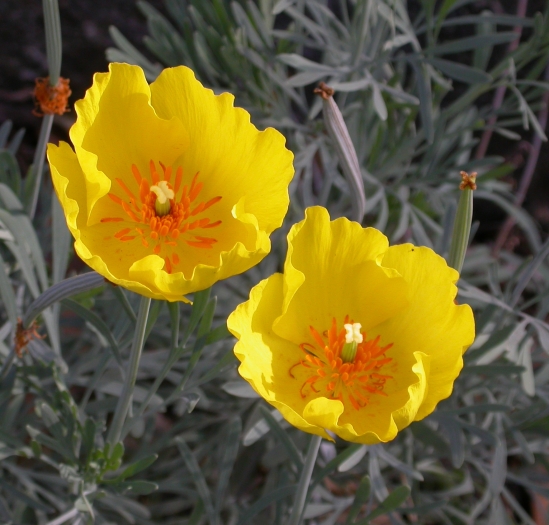Mexican Tulip Poppy
(Hunnemannia fumariifolia)
Mexican Tulip Poppy (Hunnemannia fumariifolia)
/
/

Curtis Clark assumed
CC BY-SA 2.5
Image By:
Curtis Clark assumed
Recorded By:
Copyright:
CC BY-SA 2.5
Copyright Notice:
Photo by: Curtis Clark assumed | License Type: CC BY-SA 2.5 | License URL: https://creativecommons.org/licenses/by-sa/2.5 | Uploader: Curtis Clark | Publisher: Wikimedia Commons | Title: Hunnemannia_fumariifolia_flowers_2002-10-10.jpg | Notes: User created page with UploadWizard |





























Estimated Native Range
Summary
Hunnemannia fumariifolia, commonly known as Mexican Tulip Poppy, is a deciduous perennial herb or subshrub native to the open, sunny habitats such as grasslands and rocky areas in Mexico. It has erect, somewhat woody stems at the base and can reach up to 60 cm (24 in) in height. The plant is characterized by its bright yellow, cup-shaped flowers, each formed from four overlapping petals, measuring 5–7 cm across, which bear a resemblance to tulips despite being unrelated. The flowers are particularly showy, with two sepals that typically fall away as the flower opens, blooming from mid-summer to early fall. The foliage is blue-green and finely dissected, adding to the plant’s ornamental value.
Mexican Tulip Poppy is valued for its vibrant yellow flowers and ease of maintenance. It is often grown as an annual from seed in temperate regions and is suitable for border planting, rock gardens, and as a specimen plant. The cultivar ’Sunlite’ has gained the Royal Horticultural Society’s Award of Garden Merit, indicating its exceptional performance in gardens. This plant thrives in full sun and requires well-drained soils, preferably loamy or sandy, with low water once established. It is drought-tolerant and does well in xeriscaping. While it can survive in colder climates, it benefits from the shelter of a south-facing wall. Potential problems include susceptibility to root rot in poorly drained soils and damage from slugs and snails. It is not known to be invasive when grown outside its native range.CC BY-SA 4.0
Mexican Tulip Poppy is valued for its vibrant yellow flowers and ease of maintenance. It is often grown as an annual from seed in temperate regions and is suitable for border planting, rock gardens, and as a specimen plant. The cultivar ’Sunlite’ has gained the Royal Horticultural Society’s Award of Garden Merit, indicating its exceptional performance in gardens. This plant thrives in full sun and requires well-drained soils, preferably loamy or sandy, with low water once established. It is drought-tolerant and does well in xeriscaping. While it can survive in colder climates, it benefits from the shelter of a south-facing wall. Potential problems include susceptibility to root rot in poorly drained soils and damage from slugs and snails. It is not known to be invasive when grown outside its native range.CC BY-SA 4.0
Plant Description
- Plant Type: Herb, Subshrub
- Height: 2-3 feet
- Width: 1-2 feet
- Growth Rate: Moderate
- Flower Color: Yellow
- Flowering Season: Summer, Fall
- Leaf Retention: Deciduous
Growth Requirements
- Sun: Full Sun
- Water: Low
- Drainage: Fast
Common Uses
Low Maintenance, Salt Tolerant, Showy Flowers
Natural Habitat
Open, sunny habitats such as grasslands and rocky areas in Mexico
Other Names
Common Names: Goldencup, Tulip-Poppy, Mexican Tulip-Poppy, Tulip Poppy, Guldvallmo, Amapola Tulipan, Mexikanischer Tulpenmohn
Scientific Names: , Hunnemannia fumariifolia, Chryseis fumariifolia, Eschscholzia fumariifolia,
GBIF Accepted Name: Hunnemannia fumariifolia Sweet